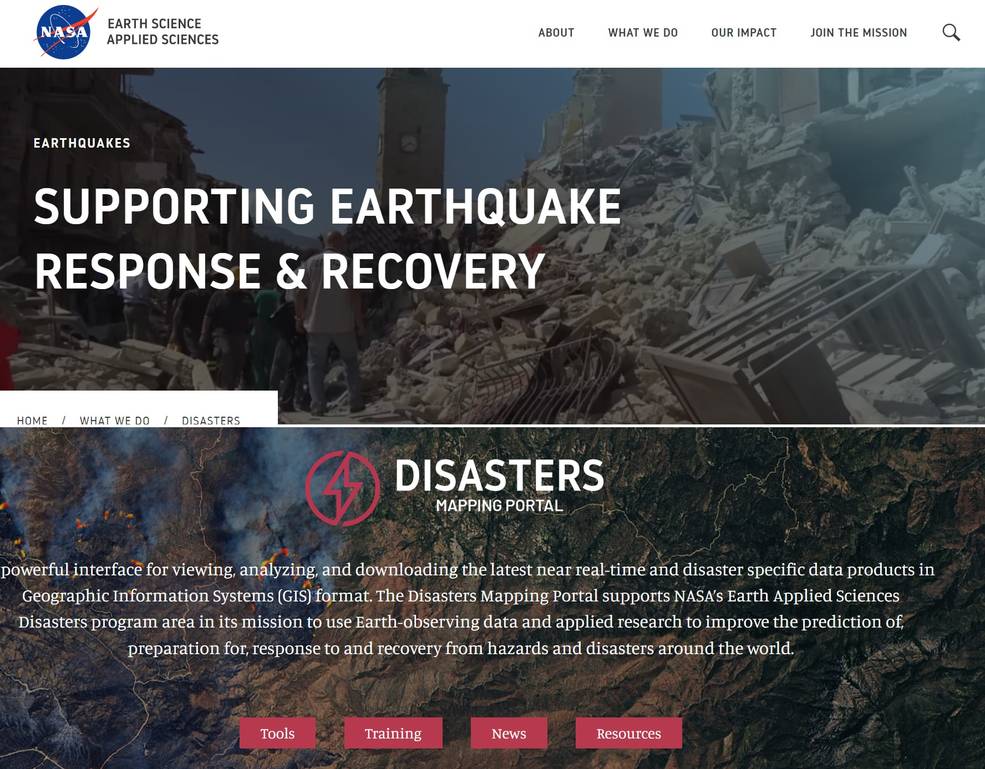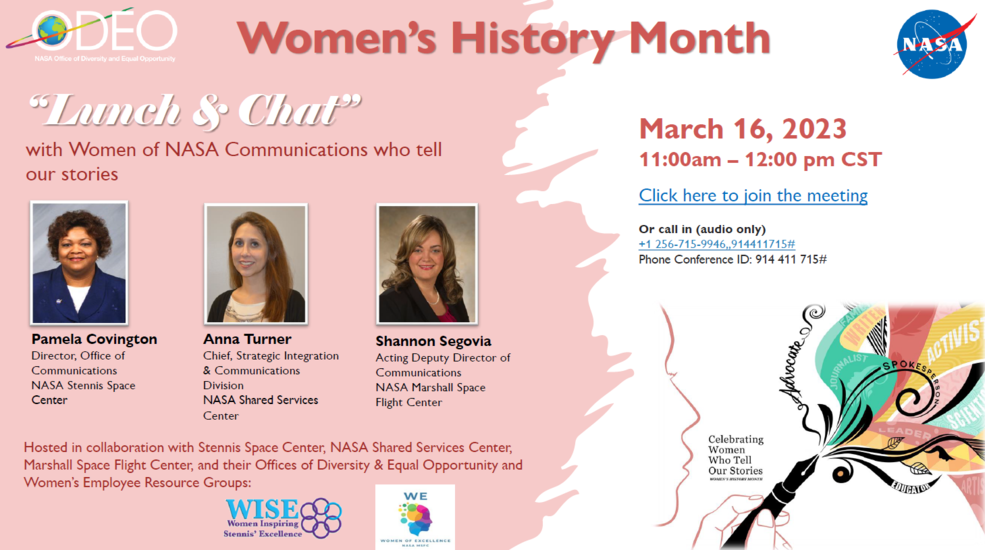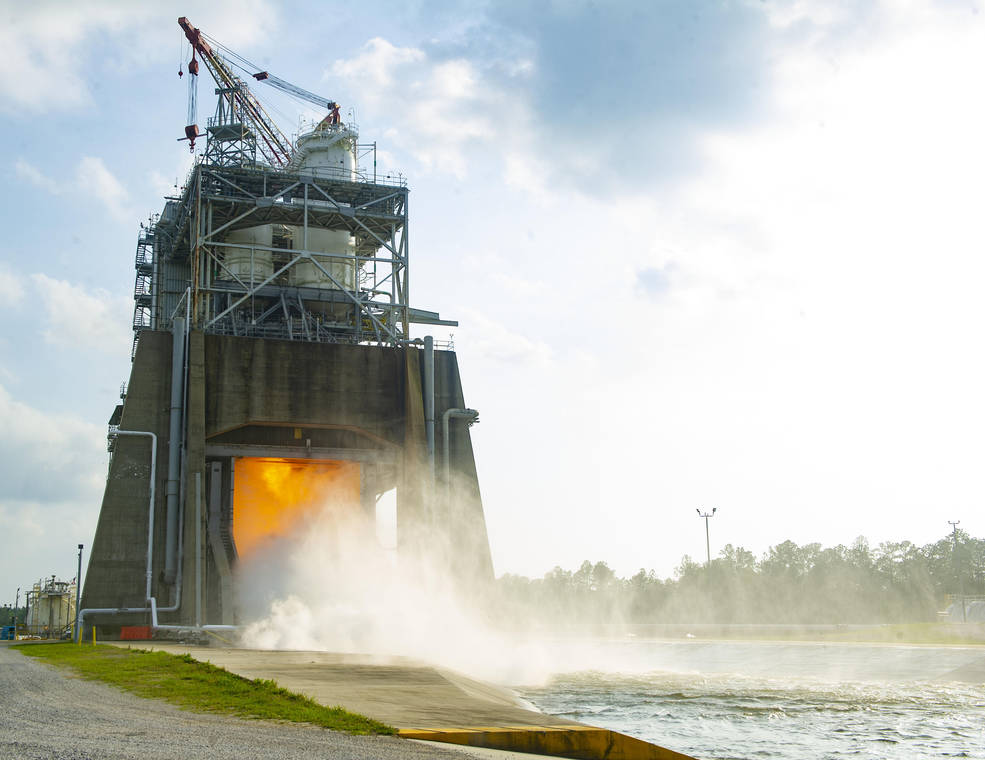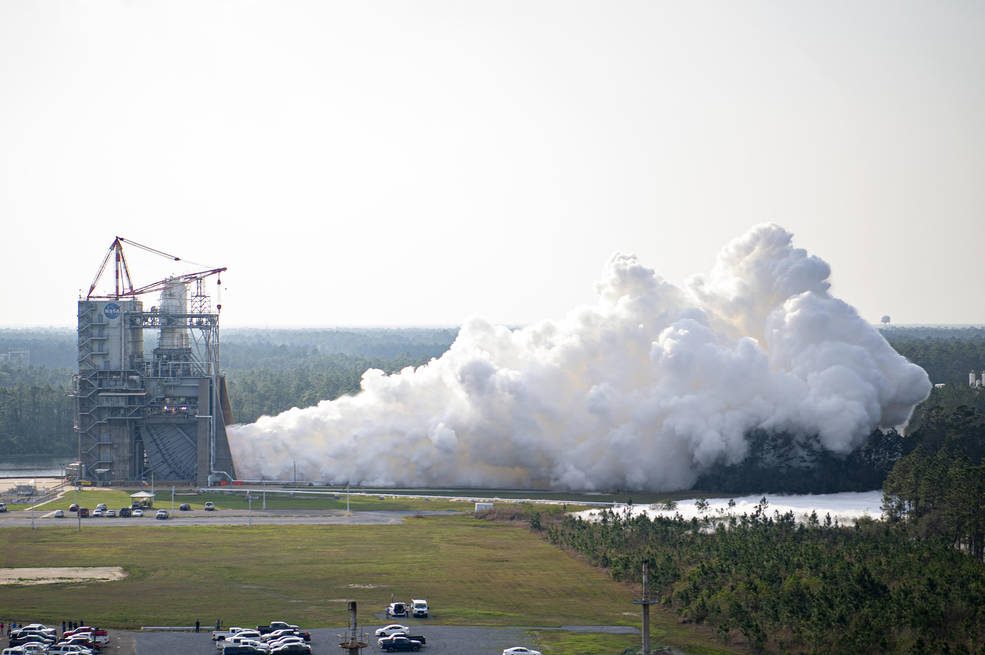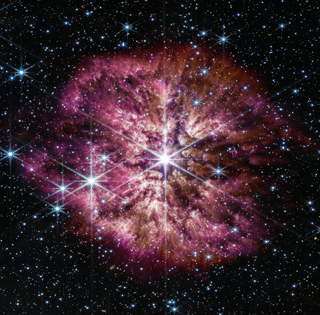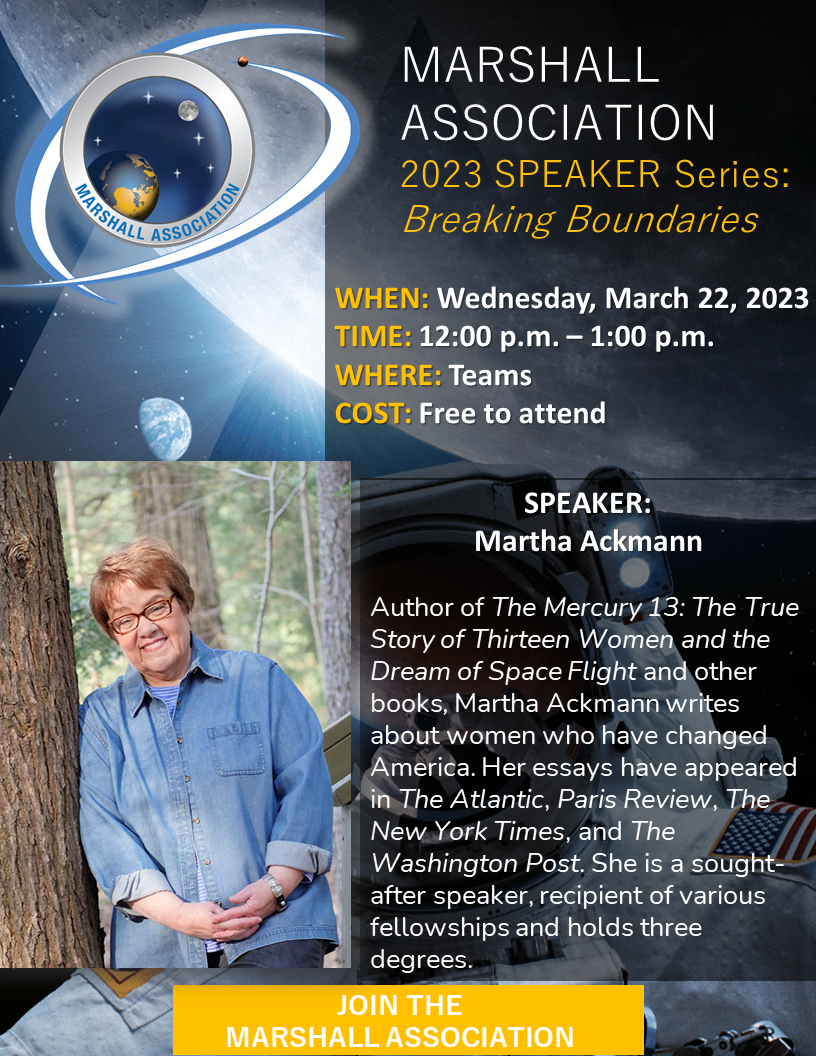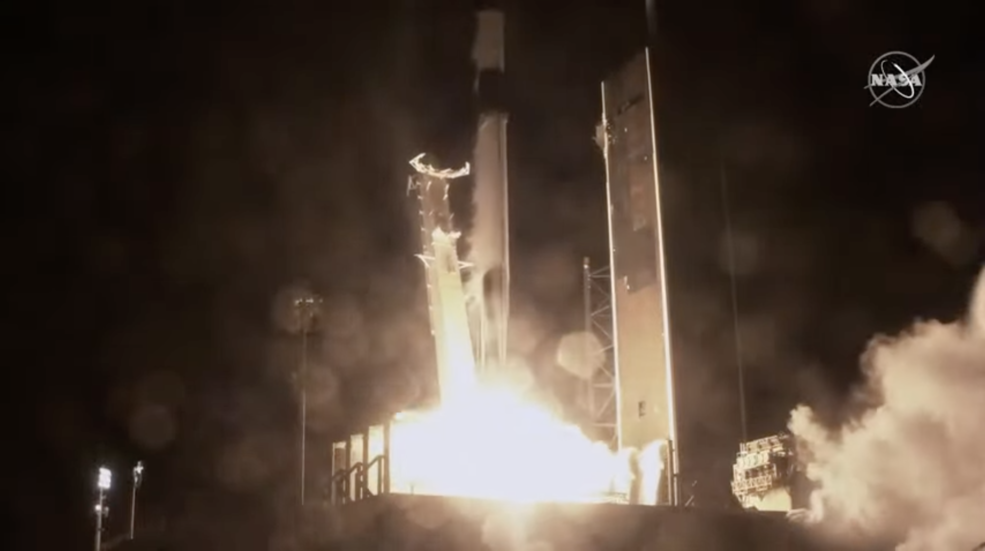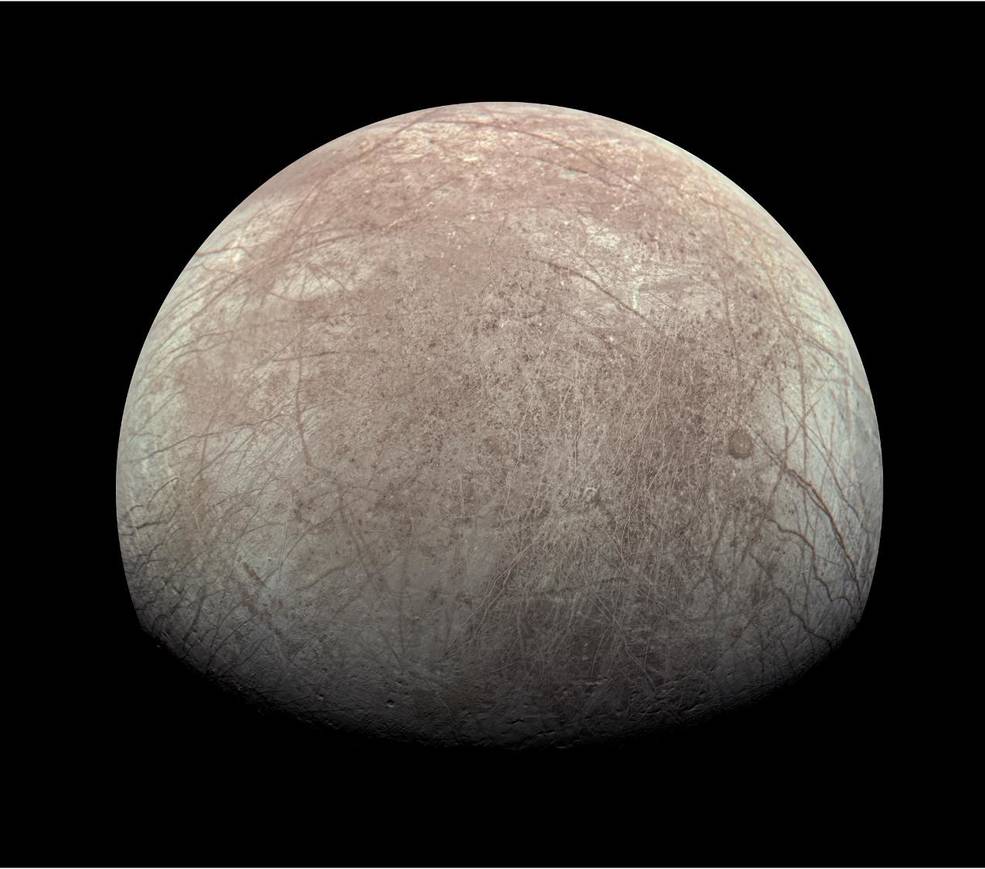The Marshall Star for March 15, 2023.
In This Week’s Star
- President’s Fiscal Year 2024 Budget Strengthens NASA, Space Economy
- NASA Disasters Program Aids Relief Efforts Following Turkey, Syria Quakes
- Marshall Employee Resource Group Seeks to ‘Amplify Women’s Voices’
- NASA Continues Test Series for Redesigned Artemis Moon Rocket Engines
- Webb Telescope Captures Rarely Seen Prelude to Supernova
- Martha Ackmann Guest for March 22 Marshall Association Speaker Series
- Rocket Science in 60 Seconds: What Did NASA Learn from the First Flight of SLS?
- NASA, SpaceX Dragon to Deliver Heart Studies, More to Space Station
- Study Finds Ocean Currents May Affect Rotation of Europa’s Icy Crust
President’s Fiscal Year 2024 Budget Strengthens NASA, Space Economy
The Biden-Harris Administration released the President’s Budget for Fiscal Year 2024 on March 9, and it will allow NASA to continue exploring the secrets of the universe for the benefit of all through Artemis, the Mars Sample Return mission, and other efforts.
“The budget details a blueprint to grow the economy from the bottom up and middle out,” said NASA Administrator Bill Nelson. “At NASA, we support good-paying American jobs, stir imaginations, and excite the world to gaze up at the heavens and reflect on our place in the universe.”
The budget allows NASA to monitor and protect the planet, advance sustainable aviation, better support orbital debris management, develop innovative new technologies, and inspire the Artemis Generation.
“President Biden’s budget will help us explore new cosmic shores, continue to make strides in traveling to and working in space and on the Moon, increase the speed and safety of air travel with cutting-edge technologies, and help protect our planet and improve lives here on Earth,” Nelson said.
The full fiscal year 2024 budget was released March 13 and includes specifics for NASA’s Marshall Space Flight Center and the Michoud Assembly Facility. In a message to the workforce, Marshall Director Jody Singer said the budget request for Marshall is $5.3 billion, an increase of about 8% from last year’s enacted budget.
“The funding request offers steady and positive continued backing for our programs and projects and allows us to pursue our center’s new strategy, which aligns closely with the agency blueprint objectives for a sustained human presence and exploration throughout the solar system,” Singer said.
“It allows Marshall to continue developing dynamic technologies for advanced propulsion and space systems, searching for a better understanding of our solar system and Earth, and to build and enable future partnerships to further space exploration.”
The budget details a blueprint to strengthen the economy, including supporting NASA’s investments in public/private partnerships. At NASA, the budget will:
- Build on the successful Artemis I mission and pave the way for a long-term presence at the Moon. The budget’s $8.1 billion to enable unprecedented lunar exploration activities also will prepare for the next giant leap, sending astronauts to Mars, through NASA’s Moon to Mars exploration approach.
- Further new scientific discovery in our solar system and beyond. The budget provides $949 million for the U.S.-led Mars Sample Return mission, which will return rock and soil samples to Earth to expand our understanding of the solar system and pave the way for human exploration. The budget’s almost $2.5 billion for Earth Science includes the Earth System Observatory and will provide open access to actionable data and information on climate change and natural hazards for scientists, decision-makers, and the public.
- Support a future in low-Earth orbit. Regular crewed missions to the International Space Station will enable multiple commercial partners to build a robust space economy where NASA is one of many customers. The budget also invests $39 million to better understand the orbital debris environment and explore approaches to ensure safe access to space.
- Advance U.S. leadership in technology innovation in aviation and space. The budget invests more than $500 million in a suite of technologies that will help meet the administration’s goal of net-zero carbon emissions from the aviation sector no later than 2050. The budget’s $1.39 billion to support the research and development of new technologies will advance our space exploration capabilities and create jobs through the growth of commercial space companies that will both use and provide new technologies.
- Engage diverse learners in NASA’s mission to create our nation’s next generation of scientists, engineers, and explorers – the Artemis Generation. The budget’s $158 million for NASA’s Office of STEM Engagement will engage more students through enhanced partnerships and platforms. This includes expanding opportunities for students from underrepresented communities.
Building on the president’s strong record of fiscal responsibility, the budget more than fully pays for its investments by reducing deficits over the next decade.
For more information on NASA’s fiscal year 2024 discretionary request, visit here.
NASA Disasters Program Aids Relief Efforts Following Turkey, Syria Quakes
By Rick Smith
On Feb. 6, an earthquake measuring 7.8 on the Richter scale struck Turkey and Syria – the second-worst quake in the region in 350 years. According to official sources, more than 55,700 people died, and millions more were displaced or left homeless. Tens of thousands of search and rescue personnel mounted relief operations, only to find their access to the region hindered by winter storms and disruptions to roads and communications systems.
To pinpoint areas most direly in need of quick response, help identify access routes, and detect challenges associated with the quake and its aftermath, regional decision makers turned to experts around the world – including NASA’s Disasters program area, part of the agency’s Earth Science Applied Sciences Program.
The Disasters program leads a cross-center, coordinated system of disaster response that employs a wide array of Earth-observing satellites, climate and environmental data, and applied research to help prepare for catastrophic events around the world and to aid risk reduction and response when they occur. NASA Earth science researchers and satellite observation teams coordinate with local and regional governments, delivering near real-time information to aid response teams and to provide tools that could help safeguard lives and resources in the future.
Lori Schultz, a physical research scientist specializing in satellite applications research at NASA’s Marshall Space Flight Center, is coordinating NASA’s disaster response efforts for Syria and Turkey. She says Marshall’s long history of applied Earth science research has long been a critical tool in aiding NASA’s disaster response activities.
“People forget that NASA spends a vast amount of its time studying the planet we live on,” Schultz said. “Our formula for choosing from all those available satellite resources, picking which data to select, adapt, and refine, was simple: Can we do something with this information that will help a community in need and provide aid in a crisis?”
In the case of the quakes in Syria and Turkey, they can. Once activated, the team participated in ongoing interagency coordination calls hosted by the United States Geological Survey (USGS) and the U.S. Agency for International Development (USAID) to assess additional stakeholder needs both domestically and across the region, providing science expertise to aid additional recovery efforts.
That support comes from all across NASA. Researchers at NASA’s Jet Propulsion Laboratory, for example, who extrapolate information from synthetic aperture radar data, helped supply surface displacement maps identifying detailed landscape changes, which helps scientists understand the underlying seismic activity. Damage proxy maps also can be derived, highlighting areas where the quake’s motion may have caused the most damage to buildings and infrastructure. NASA and its partners routinely share such maps with the U.S. State Department, the World Bank, and research institutions providing support in the region.
Teams at NASA’s Goddard Space Flight Center also used data from NASA’s Commercial SmallSat Data Acquisition program to help identify areas that experienced landslides during the quake – data that will be added to the global landslide database to help refine models and identify areas prone to increased landslide risk. And Marshall researchers processed imagery – including flooding from damaged earthen dams along the Orontes River flowing through both Syria and Turkey – from publicly available satellites including the Landsat series operated by NASA and USGS and the European Space Agency’s Copernicus Sentinel 1 and 2 satellites. All that data aids infrastructure assessment and situational awareness in the region as recovery activities continue.
NASA’s role in disaster response has grown more sophisticated in the 21st century. Researchers at Marshall had long excelled at tracking and studying tornadoes, hurricanes, lightning storms, and other severe weather. In 2002, scientists there founded the Short-term Prediction Research and Transition (SPoRT) project, designed to extrapolate information from a host of NASA satellites and ground and space imagers, disseminating useful data in near real-time to meteorologists and other decision-makers to improve short-term local and regional weather forecasts – and perhaps save lives.
Over time, Earth scientists saw more and more real-world value among their programs, much of it ripe for use by stakeholders and policymakers. Earth-observing satellites, such as NASA Terra, Aqua, and Landsat series satellites, have been successfully used by the National Weather Service to help map damage tracks caused from tornadoes, a project led at Marshall Space flight Center and funded by the Disasters Program.
“From tornadoes to wildfires to volcanoes, NASA began making connections across the agency and among our academic and commercial partners around the world, identifying what datasets and skillsets were available, which NASA teams were best equipped to respond, and how to most effectively support for major disasters,” Schultz said.
Will NASA’s increased focus on disaster response and mitigation have a long-term impact and save more lives? Schultz and her colleagues are hopeful.
“You give people the best information you have in hand, making it as accessible and useful as you can, and you just hope they make good decisions with it,” she said. “But I am definitely heartened by the fact that people are looking at Earth a little more closely than they may have done in the past and looking at ways we could mitigate a variety of disasters. All we can do is keep paying it forward.”
Smith, a Manufacturing Technical Solutions employee, supports Marshall’s Office of Strategic Analysis & Communications.
Marshall Employee Resource Group Seeks to ‘Amplify Women’s Voices’
Marshall to Host Women’s History Month Events in March
Team members at NASA’s Marshall Space Flight Center are invited to a pair of upcoming events celebrating Women’s History Month and the unique roles women have played in support of the nation’s space program.
On March 16 at 11 a.m. CST, the Office of Diversity and Equal Opportunity will host a virtual “Lunch & Chat” discussion. Discussing the roles of women in NASA communications and the importance of diverse voices and perspectives across the agency will be Shannon Segovia, acting deputy director of communications at Marshall; Pamela Covington, director of the Office of Communications at NASA’s Stennis Space Center; and Anna Turner, chief of the Strategic Integration & Communications Division at the NASA Shared Services Center.
On March 28, Marshall’s Office of Diversity and Equal Opportunity also will host a formal Women’s History Month program starting at 10 a.m. in Activities Building 4316. Huntsville news anchor and community advocate Liz Hurley will be the keynote speaker. Dancers from Oakwood Academy in Huntsville also will perform at the event and refreshments will be served.
“Celebrating Women Who Tell Our Stories” is the 2023 theme for Women’s History Month, which runs through March 31.
By Rick Smith
The theme for Women’s History Month 2023 is “Celebrating Women Who Tell Our Stories.” The “Women of Excellence” Employee Resource Group at NASA’s Marshall Space Flight Center hopes that theme will inspire every woman to recognize the power in her own voice – and use it.
“Too often, being a woman means keeping quiet in certain situations,” said Amanda Otieno, manager of the Federal Women’s Program in Marshall’s Office of Diversity and Equal Opportunity. “It’s our mission to amplify women’s voices, to encourage one another to speak, to tell our stories. We all have something of value to contribute.”
The group strives to cultivate an inclusive, diverse workplace in keeping with NASA’s missions and objectives and in partnership with the goals of the Office of Diversity and Equal Opportunity. Its overarching purpose? To help Marshall women reach their full potential as NASA professionals, afforded the same opportunities for advancement, visibility, and career satisfaction as their male counterparts.
Those goals actively support the NASA Equity Plan, which seeks to make diversity and equity core components of every NASA mission and to identify and remove career barriers that hinder historically underserved and underrepresented communities.
Currently about 30 members strong, the Women of Excellence group meets every other week to network, share updates, and celebrate one another’s accomplishments. They also host social gatherings at least once per quarter, and the chairpersons meet virtually once a month with employee resource group chairs across NASA – ensuring new ideas and lessons learned are widely shared to benefit the agency as a whole.
“There is power in human connection,” said LaBreesha Batey, deputy chair of the group and a program analyst in the Human Landing Systems Office at Marshall. “We meet to discuss ways to achieve our goals, to devise strategies for overcoming professional and personal challenges, and to fortify one another and boost our collective morale.”
Discussion topics during regular meetings range from battling imposter syndrome among male co-workers and potentially unconscious bias among elder colleagues to the challenges of balancing a career with household or parental responsibilities.
“It can seem insurmountable to achieve one’s career goals while also juggling the demands of parenthood – daycare, preschool, early education, or special education,” said group chair Denise Smithers, a supervisory budget analyst in Marshall’s Office of the Chief Financial Officer. “But we’re not the first to navigate these difficult waters. Others who previously faced the same challenges are quick to step up as mentors.”
Like all Marshall employee resource groups, Women of Excellence is open to any Marshall civil service employee or contractor – including men.
“Male allies are a vital part of networking and building beneficial relationships across the center, offering welcome perspectives and helping us to foster growth and inclusivity,” Batey said. “We definitely would welcome them in.”
The group also engages with the community and with local and regional classrooms, inspiring new generations to pursue science, technology, engineering and mathematics-related careers in the space program and related fields.
Smithers recently visited a local elementary school, where a third-grader asked whether she really worked for NASA. “The child sounded so surprised that women held so many leadership roles at Marshall,” she said. “It deepened my resolve to pay it forward, helping to make new generations aware of the opportunities we can help them pursue.”
She’s also proud that the resource group and its enthusiastic participants exist to lend those young people guidance and insight.
“To be able to help empower young women at the very start of their career is exhilarating,” Smithers said. “I’m proud that the next generation will enjoy all the benefits of joining a diverse, inclusive, welcoming workforce that truly reflects our nation.”
Team members interested in joining the group should contact Batey, Otieno, or Smithers directly.
Marshall supports a variety of employee resource groups. More information is available here. Team members also are encouraged to check out the monthly “Talk Equity, Diversity, & Inclusion” newsletter on Inside Marshall.
Smith, a Manufacturing Technical Solutions employee, supports Marshall’s Office of Strategic Analysis & Communications.
NASA Continues Test Series for Redesigned Artemis Moon Rocket Engines
NASA’s testing for redesigned RS-25 engines to be used on future Space Launch System (SLS) missions continued with a March 8 full-duration hot fire at NASA’s Stennis Space Center.
The test, conducted on the Fred Haise Test Stand at Stennis, was the third of the year and part of an ongoing certification hot fire series. It also was the third test since an upgraded nozzle was installed on the RS-25 engine just prior to a Feb 8 hot fire. The redesigned engines provided by lead SLS engines contractor Aerojet Rocketdyne will be used on future Artemis flights to the Moon, beginning with Artemis V, as NASA continues its mission to explore the secrets of the universe for the benefit of all.
“Early indications are that the nozzle is working well,” said Mike Lauer, deputy program manager of RS-25 engines at Aerojet Rocketdyne. “Even though we changed manufacturing methods, we did not want to radically change the performance of the nozzle. We are very pleased that the nozzle appears to be performing very much in line with our previous history.”
Operators fired the RS-25 engine during the test for a scheduled 520 seconds and up to 113% power level. During missions to the Moon, engines fire for about 500 seconds and up to the 111% power level to help SLS lift the Orion spacecraft and other payloads to orbit. With added seconds and the increased power level during ground tests, engineers can learn more about engine performance and provide a margin of operational safety.
The nozzle, or bell-shaped part at the bottom of the RS-25 engine, helps generate thrust by ejecting the engine’s exhaust at maximum speed to propel SLS to space. It is one of multiple upgraded components on the redesigned engine and also critical in ensuring efficiency by using a minimum amount of propellants, or fuel, to generate thrust and help propel the rocket to space. The nozzle is one reason the RS-25 is one of the most fuel-efficient rocket engines in the world.
Over the course of the storied history of the RS-25 engine, many components have gone through changes or upgrades. One component that mostly went unchanged was the nozzle.
For redesigned RS-25 engines, however, a team focused on re-engineering every part of the nozzle. This included using precision machining to improve production of the more than 1,000 tubes that comprise the nozzle wall. These tubes are critical in flowing super-cold liquid hydrogen to keep the nozzle cool. The team also is using 3D printing to manufacture selected nozzle parts.
Upgrades to the nozzle include a new type and amount of insulation, which is a critical consideration since the RS-25 engines are exposed to more heat during SLS launches than previous space shuttle missions. SLS features four RS-25 engines instead of the three main engines used for the space shuttle and the proximity of the RS-25 nozzle to the SLS solid rocket boosters is closer than on the space shuttle.
The goal of the upgrades is to streamline the nozzle production process, while making it more cost efficient and still achieving the same performance level as with previous RS-25 engines. While new manufacturing methods have been incorporated into the production of the nozzle, the shape, length, and diameter remain the same.
Sixteen main engines remained from the shuttle program. All were modified and tested at Stennis for use on the first four Artemis missions.
NASA’s Marshall Space Flight Center manages the SLS Program.
Webb Telescope Captures Rarely Seen Prelude to Supernova
The rare sight of a Wolf-Rayet star – among the most luminous, most massive, and most briefly detectable stars known – was one of the first observations made by NASA’s James Webb Space Telescope in June 2022. Webb shows the star, WR 124, in unprecedented detail with its powerful infrared instruments. The star is 15,000 light-years away in the constellation Sagittarius.
Massive stars race through their lifecycles, and only some of them go through a brief Wolf-Rayet phase before going supernova, making Webb’s detailed observations of this rare phase valuable to astronomers. Wolf-Rayet stars are in the process of casting off their outer layers, resulting in their characteristic halos of gas and dust. The star WR 124 is 30 times the mass of the Sun and has shed 10 Suns’ worth of material – so far. As the ejected gas moves away from the star and cools, cosmic dust forms and glows in the infrared light detectable by Webb.
The origin of cosmic dust that can survive a supernova blast and contribute to the universe’s overall “dust budget” is of great interest to astronomers for multiple reasons. Dust is integral to the workings of the universe: It shelters forming stars, gathers together to help form planets, and serves as a platform for molecules to form and clump together – including the building blocks of life on Earth. Despite the many essential roles that dust plays, there is still more dust in the universe than astronomers’ current dust-formation theories can explain. The universe is operating with a dust budget surplus.
Webb opens up new possibilities for studying details in cosmic dust, which is best observed in infrared wavelengths of light. Webb’s Near-Infrared Camera (NIRCam) balances the brightness of WR 124’s stellar core and the knotty details in the fainter surrounding gas. The telescope’s Mid-Infrared Instrument (MIRI) reveals the clumpy structure of the gas and dust nebula of the ejected material now surrounding the star. Before Webb, dust-loving astronomers simply did not have enough detailed information to explore questions of dust production in environments like WR 124, and whether the dust grains were large and bountiful enough to survive the supernova and become a significant contribution to the overall dust budget. Now those questions can be investigated with real data.
Stars like WR 124 also serve as an analog to help astronomers understand a crucial period in the early history of the universe. Similar dying stars first seeded the young universe with heavy elements forged in their cores – elements that are now common in the current era, including on Earth.
Webb’s detailed image of WR 124 preserves forever a brief, turbulent time of transformation, and promises future discoveries that will reveal the long-shrouded mysteries of cosmic dust.
The James Webb Space Telescope is the world’s premier space science observatory. Webb will solve mysteries in our solar system, look beyond to distant worlds around other stars, and probe the mysterious structures and origins of our universe and our place in it. Webb is an international program led by NASA with its partners, ESA (European Space Agency), and CSA (Canadian Space Agency).
Martha Ackmann Guest for March 22 Marshall Association Speaker Series
Martha Ackmann, author of The Mercury 13: The True Story of 13 Women and the Dream of Space Flight, will be the guest speaker for the Marshall Association Speaker Series on March 22. The meeting topic follows this year’s theme of Breaking Boundaries, and is from noon to 1 p.m. It can be heard via Teams link here. Jody Singer, director of NASA’s Marshall Space Flight Center, will introduce Ackmann. March is Women’s History Month. In addition to The Mercury 13, Ackmann has published other books and writes about women who have changed America. A longtime member of the Gender Studies Department at Mount Holyoke College, Ackmann taught a seminar on Emily Dickinson in the poet’s house in Amherst, Massachusetts. She is the recipient of fellowships from the John Simon Guggenheim Foundation and the Radcliffe Institute for Advanced Study at Harvard University. Ackmann holds a Bachelor of Arts from Lindenwood College, a Master of Art from Middlebury College’s Bread Loaf School of English, and a doctorate from the University of Massachusetts. She lives in western Massachusetts. For more information on the Marshall Association and how to join, visit their page on Inside Marshall. (NASA)
Rocket Science in 60 Seconds: What Did NASA Learn from the First Flight of SLS?
Rocket Science in 60 Seconds gives you an inside look at the work being done at NASA to explore deep space. NASA’s Space Launch System (SLS) rocket launched the Artemis I mission on Nov. 16, 2022, sending an uncrewed Orion spacecraft on a 25.5-day mission beyond the Moon and back. Now, NASA engineers are analyzing data from the flight test to benefit the production, assembly, and testing of future SLS Moon rockets that will safely send astronauts to the Moon. In this episode, SLS associate program manager Sharon Cobb gives a brief overview of the powerful SLS rocket and discusses what teams have learned from its first flight. (NASA)
NASA, SpaceX Dragon to Deliver Heart Studies, More to Space Station
NASA has another cargo shipment en route to the International Space Station following a successful Falcon 9 launch of SpaceX’s 27th resupply mission for the agency.
Carrying more than 6,200 pounds of science experiments, crew supplies, and other cargo, the SpaceX Dragon spacecraft was launched to the space station by a Falcon 9 rocket at 7:30 p.m. CDT March 14 from NASA’s Kennedy Space Center. The cargo spacecraft is scheduled to remain at the station for about 30 days.
Among the science experiments Dragon is delivering to the space station for NASA and its partners are:
3D Heart Cells, Tissue
The first Cardinal Heart investigation conducted aboard the space station showed that four weeks of microgravity exposure can cause significant changes in heart cell function and gene expression. Researchers concluded that these changes could lead to long-term medical issues. The Cardinal Heart 2.0 experiment builds on these results, using heart organoids, 3D structures made up of all the different types of cells, to test whether clinically approved drugs reduce these microgravity-induced changes in heart cell function. Results could support the development of effective drug combinations to improve the health of astronauts and patients on Earth.
The Engineered Heart Tissues-2 study continues work with 3D cultured cardiac muscle tissue to assess human cardiac function in microgravity. Previous work with 3D cultures in space detected changes at the cellular and tissue level that could provide early indication of the development of cardiac disease. This investigation tests whether new therapies prevent these adverse spaceflight effects from occurring. The model used in this study has potential use in drug development and other applications related to diagnosing and treating cardiac dysfunction on Earth.
Cardinal Heart 2.0 and Engineered Heart Tissues-2 are the final two experiments comprising the National Institutes for Health and International Space Station National Lab’s Tissue Chips in Space initiative. Researchers hope to learn more about the impact of microgravity on human health and disease, translating that understanding to improved human health on Earth.
Student Ball Clamp Monopod Project
NASA’s HUNCH (High school students United with NASA to Create Hardware) program enables students to fabricate real-world products for NASA as they apply their science, technology, engineering, and mathematics skills. The HUNCH Ball Clamp Monopod attempts to address astronaut comments on the difficulty of positioning video or still cameras in the middle of a module. The student-manufactured project is composed of an aluminum monopod fitted with a camera shoe and ball clamp that can be attached to a standard space station handrail. The ball clamp serves as a pivoting platform for photography and video.
Liquid Life Support Systems
Because microgravity makes it difficult to control the flow of liquids, the space station has been unable to take advantage of carbon dioxide removal methods that use specialized liquids. Liquid-based carbon dioxide removal systems such as those on submarines offer higher efficiency than other types of systems. The CapiSorb Visible System study demonstrates liquid control using capillary forces, the interaction of a liquid with a solid that can draw a fluid up a narrow tube, which are characteristic of liquids that can absorb carbon dioxide. This is an important consideration for future longer-duration space missions where improved efficiency will support crews over many months or years.
Bacterial Biofilms
Microbial biofilms are combinations of microorganisms that embed themselves in a self-produced slimy matrix. Biofilms are of concern for spaceflight because they can cause damage to equipment, are resistant to cleaning agents, and can harbor microorganisms that might cause infections. The ESA (European Space Agency) Biofilms investigation studies bacterial biofilm formation and antimicrobial properties of different metal surfaces under spaceflight conditions. Antimicrobial surfaces that can inhibit biofilm growth, such as copper and its alloys with and without laser surface treatment, are used in this study. This project provides additional information to help develop suitable antimicrobial surfaces for future spacecraft.
Lifeform Origins, Survival
An investigation from JAXA (Japan Aerospace Exploration Agency) known as Tanpopo-5 could provide insight into whether terrestrial life can survive in space and help scientists understand the key ingredients that sparked life on Earth. The experiment studies the response to space exposure in radiation-resistant microbes, moss spores, and biochemical compounds including amino acids. Amino acids have been detected in extraterrestrial bodies such as meteorites and are possible precursors to life on Earth. Tanpopo-5 follows four earlier experiments which could all inform strategies to protect other planets from contamination by humans and for returning samples from other planets safely to Earth.
These are just a few of the hundreds of investigations currently conducted aboard the orbiting laboratory in the areas of biology and biotechnology, physical sciences, and Earth and space science. Advances in these areas will help keep astronauts healthy during long-duration space travel and demonstrate technologies for future human and robotic exploration beyond low-Earth orbit to the Moon and Mars.
The Payloads Operations Integration Center at NASA’s Marshall Space Flight Center is the primary science and research command post for the space station’s investigations and payloads. Marshall’s POIC team members coordinate all the USA, Europe, Japan, and Canada’s science and commercial experiments on the space station, managing communications between the crew and researchers worldwide. Marshall’s exclusive capabilities at the POIC empower science experts and researchers around the world to perform cutting-edge science in the unique microgravity environment of space.
Study Finds Ocean Currents May Affect Rotation of Europa’s Icy Crust
NASA scientists have strong evidence that Jupiter’s moon Europa has an internal ocean under its icy outer shell – an enormous body of salty water swirling around the moon’s rocky interior. New computer modeling suggests the water may actually be pushing the ice shell along, possibly speeding up and slowing down the rotation of the moon’s icy shell over time.
Scientists have known that Europa’s shell is probably free-floating, rotating at a different rate than the ocean below and the rocky interior. The new modeling is the first to show that Europa’s ocean currents could be contributing to the rotation of its icy shell.
A key element of the study involved calculating drag – the horizontal force that the moon’s ocean exerts on the ice above it. The research hints at how the power of the ocean flow and its drag against the ice layer could even account for some of the geology seen on Europa’s surface. Cracks and ridges could result from the icy shell slowly stretching and collapsing over time as it is pushed and tugged by the ocean currents.
“Before this, it was known through laboratory experiments and modeling that heating and cooling of Europa’s ocean may drive currents,” said Hamish Hay, a researcher at the University of Oxford and lead author of the study published in JGR: Planets. Hay performed the research while a postdoctoral research associate at NASA’s Jet Propulsion Laboratory in Southern California. “Now our results highlight a coupling between the ocean and the rotation of the icy shell that was never previously considered.”
It might even be possible, using measurements gathered by NASA’s upcoming Europa Clipper mission, to determine with precision how fast the icy shell rotates. When scientists compare images gathered by Europa Clipper with those captured in the past by NASA’s Galileo and Voyager missions, they will be able to examine locations of ice surface features and potentially determine if the position of the moon’s icy shell has changed over time.
For decades, planetary scientists have debated whether Europa’s icy shell might be rotating faster than the deep interior. But rather than tying it to the ocean’s movement, scientists focused on an outside force: Jupiter. They theorized that as the gas giant’s gravity pulls on Europa, it also tugs on the moon’s shell and causes it to spin slightly faster.
“To me, it was completely unexpected that what happens in the ocean’s circulation could be enough to affect the icy shell. That was a huge surprise,” said co-author and Europa Clipper Project Scientist Robert Pappalardo of JPL. “And the idea that the cracks and ridges we see on Europa’s surface could be tied to the circulation of the ocean below – geologists don’t usually think, ‘Maybe it’s the ocean doing that.’”
Europa Clipper, now in its assembly, test, and launch operations phase at JPL, is set to launch in 2024. The spacecraft will begin orbiting Jupiter in 2030, and will use its suite of sophisticated instruments to gather science data as it flies by the moon about 50 times. The mission aims to determine if Europa, with its deep internal ocean, has conditions that could be suitable for life.
Like a Pot of Water
Using techniques developed to study Earth’s ocean, the paper’s authors relied on NASA supercomputers to make large-scale models of Europa’s ocean. They explored the complexities of how the water circulates, and how heating and cooling affects that movement.
Scientists believe that Europa’s internal ocean is heated from below, due to radioactive decay and tidal heating within the moon’s rocky core. Like water heating in a pot on a stove, Europa’s warm water rises to the top of the ocean.
In the simulations, the circulation initially moved vertically, but the rotation of the moon as a whole caused the flowing water to veer in a more horizontal direction – in east-west and west-east currents. The researchers, by including drag in their simulations, were able to determine that if the currents are fast enough, there could be adequate drag on the ice above to speed up or slow down the shell’s rotation speed. The amount of interior heating – and thus, circulation patterns in the ocean – may change over time, potentially speeding up or slowing rotation of the icy shell above.
“The work could be important in understanding how other ocean worlds’ rotation speeds may have changed over time,” Hay said. “And now that we know about the potential coupling of interior oceans with the surfaces of these bodies, we may learn more about their geological histories as well as Europa’s.”
More About the Mission
Europa Clipper’s main science goal is to determine whether there are places below the surface of Jupiter’s icy moon, Europa, that could support life. The mission’s three main science objectives are to understand the nature of the ice shell and the ocean beneath it, along with their composition and geology. The mission’s detailed exploration of Europa will help scientists better understand the astrobiological potential for habitable worlds beyond our planet.
Managed by Caltech in Pasadena, California, JPL leads the development of the Europa Clipper mission in partnership with the Johns Hopkins Applied Physics Laboratory (APL) in Laurel, Maryland, for NASA’s Science Mission Directorate. APL designed the main spacecraft body in collaboration with JPL and NASA’s Goddard Space Flight Center in Greenbelt, Maryland. The Planetary Missions Program Office at NASA’s Marshall Space Flight Center executes program management of the Europa Clipper mission.


























